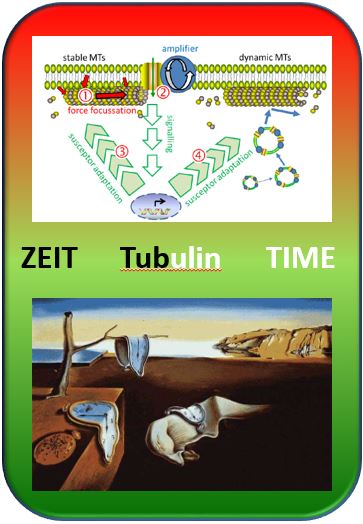2020_01 Microtubules Measure Time
What is the topic?
Plants cannot run away, when they do not like the situation. To adapt to it, they first need to sense that the environment has changed adversely. This is complex, since plants have to cope with different stress factors and their adaptation depends on their history of facing other stresses in the past. When a response changes depending on preceding stimuli and the responses to these stimuli, this is nothing else than learning, an activity, we usually expect only from organisms endowed with a nervous system.
Can plants "learn"? They neither have nerves, nor a brain!
What was our idea?
In fact, "learning" can be observed, for instance in response to cold stress. A chilling pretreatment can render plants resistant to freezing. This cold hardening is based on microtubules. In a meanwhile often quoted work (Abdrakhamanova et al. 2003) we were able to show that Siberian Winterwheat copes well with freezing conditions, because its microtubules respond very sensitively during an early phase of the stress and rapidly disappear. Using grapevine cells, where microtubules could be observed in action by virtue of a Green Fluorescent Protein coupled to them, we were able to show that microtubules are steered through reactive oxygen species and a calcium influx, both generated at the cell membrane. The dissolution of microtubules, in turn, feeds back positively upon these inputs (more...). In a later publication (Wang et al. 2019) we were then able to show that microtubules are needed to "remember" earlier periods of cold stress.
Meanwhile, numerous genes needed for cold adaptation were identified mainly by molecular genetics. However, many reports are discrepant and confusing - sometimes, such a gene is reported to promote adaptation, sometimes as impairing it. We think that this mess was created, because people ignored TIME. Molecular genetics provides "snap shots". In order to understand a process, we need to see the movie. From our previous work we knew that microtubules act as plant thermometers. Further, we had found out that this thermometer senses differently, depending on that, what it had measured in the past. The history of sensing (in other words: the experience of the plant) defines, what is sensed and how it is sensed. Such phenomena are well known from psychological physiology and are termed as Weber-Fechner law - the response to a stimulus is not constant, but depends on the history of sensing stimuli in the past. Nothing else than the base of learning.
What did we find out?
We proposed for possibilities for processing of stimuli (chemical or physical stimuli, no learning, or learning from experience). We were able to explain the very complex experimental results on the base of a model involving learning. Microtubules behave differently, depending on, whether they had been involved in sensing earlier. Thus, microtubules are acting in the core of plant learning. By considering TIME as biological factor, we could, in addition, sort, simplify, and explain the rather discrepant data on the molecular base of plant adaptation to cold. Thus, plants are able to learn, although they are not endowed with nerves and brain. However, they are endowed with microtubules.
Publication
[49] Wang L, Sadeghnejad E, Nick P (2020) Upstream of gene expression - what is the role of microtubules in cold signalling? J Exp Bot 71, 36-48. pdf

